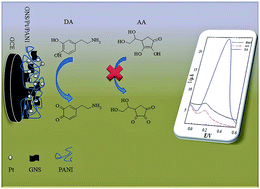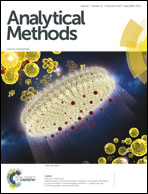Fabrication and electrochemical characterization of dopamine-sensing electrode based on modified graphene nanosheets
Abstract
Herein, by combining the unique electronic properties of graphene nanosheets (GNS) and Pt nanoparticles with the excellent properties of polyaniline (PANI), the nanocomposite of GNS/Pt/PANI was prepared and characterized by physical and chemical methods. The as-prepared GNS/Pt/PANI nanocomposite was applied for modification of a glassy carbon electrode (GCE) which served for the detection of dopamine (DA). The performance of the GNS/Pt/PANI nanocomposite was compared with the other similar nanostructures like GNS/PANI, CNT/Pt/PANI, GNS/CNT/PANI and GNS/CNT/Pt/PANI. The results exhibited more favorable electron transfer kinetics and electrocatalytic activity toward the oxidation of DA with respect to ascorbic acid (AA). For the optimized experimental and instrumental conditions, two linear calibration curves were observed, from 2.0 to 10 and 40 to 400 μM DA and with slopes of 1.53 and 0.35 μA μM−1, respectively (r = 0.99). A detection limit of 0.6 μM DA was observed at pH 7.4 for the GNS/Pt/PANI/GCE. The prepared sensor showed good sensitivity, repeatability, and reproducibility in this work.


 Please wait while we load your content...
Please wait while we load your content...